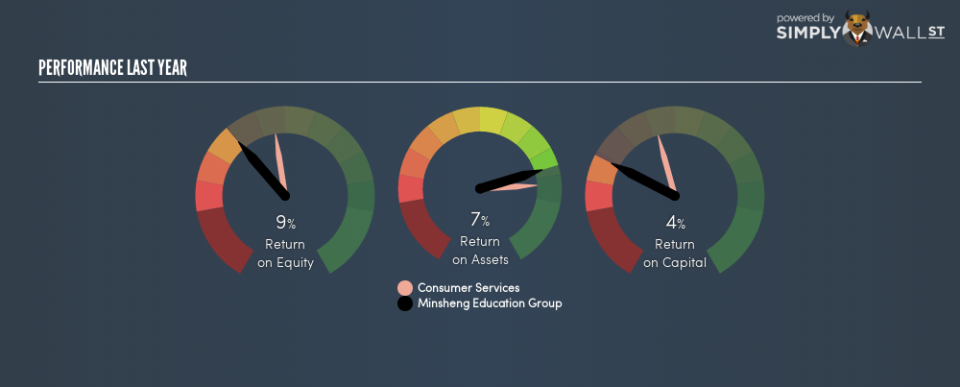Why Minsheng Education Group Company Limited’s (HKG:1569) Return On Capital Employed Might Be A Concern

Today we’ll look at Minsheng Education Group Company Limited (HKG:1569) and reflect on its potential as an investment. To be precise, we’ll consider its Return On Capital Employed (ROCE), as that will inform our view of the quality of the business.
First of all, we’ll work out how to calculate ROCE. Then we’ll compare its ROCE to similar companies. And finally, we’ll look at how its current liabilities are impacting its ROCE.
Return On Capital Employed (ROCE): What is it?
ROCE is a measure of a company’s yearly pre-tax profit (its return), relative to the capital employed in the business. Generally speaking a higher ROCE is better. Overall, it is a valuable metric that has its flaws. Author Edwin Whiting says to be careful when comparing the ROCE of different businesses, since ‘No two businesses are exactly alike.’
How Do You Calculate Return On Capital Employed?
The formula for calculating the return on capital employed is:
Return on Capital Employed = Earnings Before Interest and Tax (EBIT) ÷ (Total Assets – Current Liabilities)
Or for Minsheng Education Group:
0.045 = CN¥143m ÷ (CN¥4.1b – CN¥420m) (Based on the trailing twelve months to June 2018.)
So, Minsheng Education Group has an ROCE of 4.5%.
Check out our latest analysis for Minsheng Education Group
Does Minsheng Education Group Have A Good ROCE?
ROCE is commonly used for comparing the performance of similar businesses. We can see Minsheng Education Group’s ROCE is meaningfully below the Consumer Services industry average of 13%. This performance could be negative if sustained, as it suggests the business may underperform its industry. Regardless of how Minsheng Education Group stacks up against its industry, its ROCE in absolute terms is quite low (especially compared to a bank account). There are potentially more appealing investments elsewhere.
Minsheng Education Group’s current ROCE of 4.5% is lower than 3 years ago, when the company reported a 10% ROCE. So investors might consider if it has had issues recently.
Remember that this metric is backwards looking – it shows what has happened in the past, and does not accurately predict the future. ROCE can be misleading for companies in cyclical industries, with returns looking impressive during the boom times, but very weak during the busts. This is because ROCE only looks at one year, instead of considering returns across a whole cycle. Since the future is so important for investors, you should check out our free report on analyst forecasts for Minsheng Education Group.
How Minsheng Education Group’s Current Liabilities Impact Its ROCE
Current liabilities include invoices, such as supplier payments, short-term debt, or a tax bill, that need to be paid within 12 months. Due to the way the ROCE equation works, having large bills due in the near term can make it look as though a company has less capital employed, and thus a higher ROCE than usual. To check the impact of this, we calculate if a company has high current liabilities relative to its total assets.
Minsheng Education Group has total assets of CN¥4.1b and current liabilities of CN¥420m. As a result, its current liabilities are equal to approximately 10% of its total assets. With a very reasonable level of current liabilities, so the impact on ROCE is fairly minimal.
What We Can Learn From Minsheng Education Group’s ROCE
While that is good to see, Minsheng Education Group has a low ROCE and does not look attractive in this analysis. But note: Minsheng Education Group may not be the best stock to buy. So take a peek at this free list of interesting companies with strong recent earnings growth (and a P/E ratio below 20).
If you are like me, then you will not want to miss this free list of growing companies that insiders are buying.
To help readers see past the short term volatility of the financial market, we aim to bring you a long-term focused research analysis purely driven by fundamental data. Note that our analysis does not factor in the latest price-sensitive company announcements.
The author is an independent contributor and at the time of publication had no position in the stocks mentioned. For errors that warrant correction please contact the editor at editorial-team@simplywallst.com.

